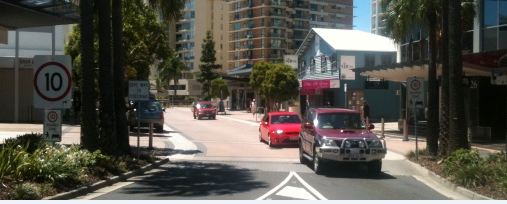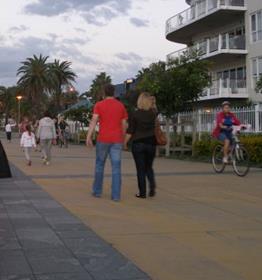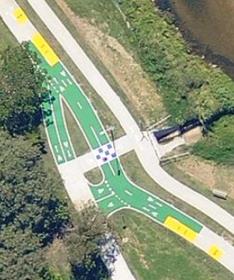Appendix B Active Travel Interventions and Options
A list of infrastructure options and interventions available to support active travel is presented below. The majority of these options are associated with the road network where road crossing facilities and interactions at intersections are of significant importance
Roads and streets
- Pedestrian streets are pedestrian only areas created by restricting traffic access or closing street to traffic eg Brisbane’s Queen Street mall shown in the following figure.
Figure 6: Pedestrian street
- Shared zone is a street that has been designed to give priority to pedestrians by significantly reducing the dominance of the motorised transport through the road environment and speed reduction eg Duporth Avenue, Maroochydore shown in the following figure.
Figure 7: Shared zone
- Traffic calming measures are interventions that impact motorised transport, aiming to improve the active transport network. These include:
- Road closure
- Half closure
- Build outs
- Gateway or entry treatment
- Chicanes
- Raised intersections
- Speed humps.
Some schematic diagrams are shown in the following figure.
Figure 8: Traffic control devices
Pathways within the road corridor
- Footpaths running adjacent to the road/carriageway
- Sealed road shoulders (mainly relevant to rural roads)
- Wide kerb-side lanes, which are widened traffic lanes adjacent to the kerb giving more space for cyclists
- Shared bus or parking lanes with cyclists
- Peak period cycle lanes
- Exclusive on-road cycle lanes can take the form of either green surface treatment and road markings, white line marking and bicycle symbol or bicycle awareness zones (BAZ) with bicycle symbols in the traffic lane. Examples are shown in the following figure.
Figure 9: On-road cycle lane facilities
- Segregated on-road cycle lanes – see following Figure.
Figure 10: Segregated bike lane within road corridor
Pathways separate to the road corridor
- Exclusive pedestrian path
- Shared pedestrian and bicycle path – see following figure
- Segregated pedestrian and cycle path – see following figure
- Exclusive cycle path.
Table 27: Shared pedestrian/cycle path and segregated pedestrian/cycle path Shared ped/cycle
- Cycle Path
- Pedestrian Path
Path upgrades or retrofitting
- Widening of an existing path
- Resurfacing of an existing path
- Ramps to improve the movement along an active travel route for cyclists and pedestrians
- Steps to improve pedestrian movements along a pathway.
Ancillary infrastructure
- Lighting along pedestrian and cyclist routes will improve safety, security and the likelihood of the facility being used particular at night time
- Seating provided at appropriate locations will improve the amenity of a facility, particularly for walkers – see following figure
Figure 11: Improve amenity of footpaths
- Water points, such as water fountains sited at appropriate locations along an active travel route
- Landscaping, such as shade planting along an active travel path or at rest areas – see following figure
- Handrails and guiderails at appropriate locations to assist users of active travel facilities – see following figure
- Security cameras, such as CCTV surveillance to improve personal security
- Emergency help points to improve personal security
- Wayfinding signage to inform people of the location and distance to the land uses in the area – see following figure
- Lifts or escalators at grade separated crossing will promote use of the crossing facility
- Non-slip surface treatments for pedestrian will improve safety of the path.
Figure 12: Wayfinding signage and guardrail
Crossings
- Dropped kerb eg pram ramps, is where part of the path along the kerb is lowered to the same level of the adjacent carriageway to allow easier use
- Blended kerb crossings is where the path and road are at the same level, these usually are formed in shared zones or by raised pedestrian crossing platforms – see following figure
Figure 13: Blended crossing across side street
- Refuge island treatments (such as medians) will enhance safety for active travellers crossing at that point
- Pedestrian platforms (such as raised crossings) remove the level difference making crossing easier for pedestrians
- Zebra crossing is marked with longitudinal road markings with traffic required to give way to pedestrians
- Mid-block pedestrian signals are traffic signals not at an intersection that stop traffic to allow crossing
- Grade separated crossing, such as overpass or bridge, underpass or tunnel that separates active travel users from motorised transport, improving safety, connectivity and promoting active travel – see following figure
Figure 14: Active travel bridge crossing over a river
- School patrol crossing usually involves a parent/guardian who controls the traffic to allow children to cross without conflict; sometimes they incorporate markers and swing signs
- Gate controlled crossing are usually found at railway crossing points to enhance safety.
Cycle path crossing treatments of side roads at priority intersections
- Bent-out treatment where off-road cycle path bends away from the road if there is sufficient space in the road reserve, with priority given to cyclists over the traffic on the side road - as shown in the following figure
- Straight crossing treatment allows the straight movements across the side road – see figure below
- Bent-in treatment provides for a one-way off-road cycle lane transitions into an on-road cycle lane thereby enabling cyclists to have priority over the side street - as shown in figure below
Figure 15: Cycle path crossing side road
- Refuge treatment within an intersection to accommodate cycle crossing while restricting vehicles to left turn movements only - as shown in following figure
Figure 16: Refuge treatment within an intersection
Further crossing treatments at roundabouts
- On-road cycle facilities within the traffic lane can take the form of the cycle lane facilities listed above (such as BAZ, green colour and line marking) with a significant concern being the speed of traffic approaching the roundabout - a mixed cycle and traffic lane roundabout is shown in the following figure
Figure 17: Mixed cycle lanes with traffic at roundabout
- Physically separated cycle lanes at grade minimise bicycle and vehicle interaction on the roadway, with cyclists crossing the arms of the roundabout similar to pedestrians - example shown in the following figure.
Figure 18: Separated cycle lanes at grade at roundabout
Further crossing treatments at signalised intersections
- Single stage signalised pedestrian crossing
- Head-start or expanded storage areas (advanced cycle stop lines) are used at signalised intersections to facilitate stacking of cyclists, allowing them to stop and wait ahead of the vehicular traffic improving safety - shown in the following figure
- Hook turn storage boxes are used as an alternative to right turn movements from the centre of the road where cyclists go straight through and wait at the corner the intersection and make the right turn manoeuvre when it is safe to do so or with through movement on the other arm – see the following figure
Figure 19: Expanded storage and hook turn at signalised intersection
- Left-turn treatments for cyclists are often required as part of channelised left turn treatment or left turn slip lanes for the vehicular traffic, which can involve cyclists sharing the left turn lane vehicles or a free-flow or bypass treatment
- Bypass of T-intersection for the through movement opposite discontinuing arm will limit delay to cyclists and be incorporated as a separated lane - as shown in the following figure - or provide for cyclists on the adjacent path
Figure 20: Bypass of T-intersection
- Bicycle loop detectors with sensitive detection arrangements should be provided at separate bicycle lane
- Push button bicycle signalised crossing should be provided where cyclists share the intersection with vehicles as detection is not always possible due to their small electromagnetic footprint.
Other strategies
- Pedestrian signals co-ordination can be useful in a city centre area with significant commuter movements to improve pedestrian travel time along the route
- Count-down timers at signalised crossings promote safety for pedestrians and give them greater knowledge of the waiting and crossing times
- Scramble crossings involve an all red signal phase for vehicles to allow pedestrian crossings in all directions at the intersection.
End-of-trip facilities
- Showers should be provided at all end-of-trip locations for cyclists
- Changing rooms should also be available for cyclists
- Lockers to store clothing and bike equipment should also be provided if the cyclist does not have space to store their items.
Bike parking
- Bike stands or racks to allow cyclists to lock their bike frame and wheels as required – see following figure
- Shared gated parking areas (such as lockable enclosure/shelter with bike stands or racks enclosed) - as shown in figure below
- Individual secure bike parking lockers are the most secure bike parking facility available – see figure below.
Figure 21: Bike racks at public transport interchange
Figure 22: Bike enclosure and locker


















